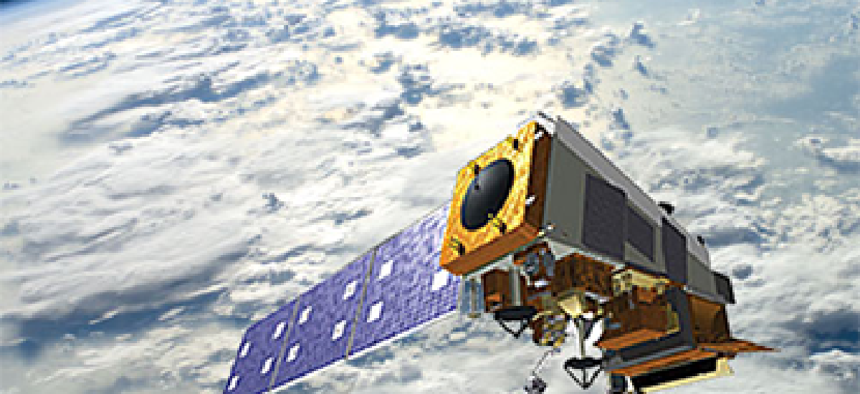International pact helps NOAA mitigate satellite data loss

A five-year agreement between the National Oceanic and Atmospheric Administration and the European Organization for the Exploitation of Meteorological Satellites at least partially helps offset a potential gap in polar-orbiting weather satellite coverage.

NASA joint polar orbiting satellite. (NASA image)
A five-year agreement between the National Oceanic and Atmospheric Administration and the European Organization for the Exploitation of Meteorological Satellites (EUMETSTAT) at least partially helps offset a potential gap in polar-orbiting weather satellite coverage.
Reached Aug. 27, the agreement continues a 30-year relationship between NOAA and EUMETSTAT and ensures that if NOAA's aging polar-orbiting satellites fail, the agency will have access to data from EUMETSAT's Metop satellites to use in its weather forecasting models.
NOAA and EUMETSAT operate a joint-polar satellite system in which the Metop satellites fly the mid-morning orbit and NOAA's polar-orbiting satellites, specifically its Suomi NPP spacecraft, fly the afternoon orbit. A third satellite operated by the Air Force's Defense Meteorological Satellite Program makes a morning orbit, with each satellite orbiting the Earth in a north-south orbit several hundred miles overhead. Data from all three orbits -- including storm direction, speed and intensity -- make up the majority of data used by the U.S. and European weather models that produce all medium-range weather forecasts.
The Suomi NPP spacecraft is a converted demonstration satellite that was launched in 2011 in hopes of mitigating the gap, but its life expectancy is not long.
Should Suomi NPP fail before 2017, when the first satellite in NOAA's next generation Joint Polar Satellite System (JPSS) is expected to be operational, a NOAA spokesperson said the agency will still have access to EUMETSAT's Metop data, thereby insuring against a loss of all data from polar-orbiting satellites.
"Thanks to our partnership with EUMETSAT, we can access their Metop data in the mid-morning orbit," the spokesperson said. "So instead of facing the possibility have having no polar-orbiting satellite data, through our partnership with EUMETSAT, we will at least have access to data from one of the two key orbits, diminishing the impact of a potential gap."
NOAA is in a partnership with NASA to develop the $13 billion JPSS program, but it has come under fire in recent months from oversight bodies, including the Government Accountability Office, which recommended NOAA come up with a detailed mitigation plan in case a gap occurs.
In February, GAO added the JPSS program to its biennial list of high-risk programs and topics
"Right now, gaps in polar orbiting satellites that provide early, midday and afternoon warnings to feed computer weather prediction models and provide 3-, 4- and 7-day forecasts [could] occur as early as 2014, and could last up to 53 months," Comptroller General Gene Dodaro told the House Oversight and Government Reform Committee on Feb. 14.
The gap endangers property and lives, and could have significant economic consequences as well, Dodaro added.
The JPSS program received some good news over the summer, with its first new satellite – JPSS-1 – passing two programmatic reviews at NASA's Goddard Space Flight Center. The reviews show the program is on track to meet higher-level critical milestones, and indicates the satellite, ground system and launch service and operations measure up to mission objectives.
In the meantime, NOAA is exploring other ways to mitigate a potential gap in data from its polar-orbiting satellites. Potential options include extending the life of the Suomi NPP satellite and improvements in the quality of non-satellite data, weather modeling and data assimilation.
"NOAA is actively -- and aggressively -- working to improve the operation of the Suomi-NPP satellite and the ground system to preserve and extend the life of the spacecraft, so that any potential gap between it and JPSS-1 is minimized," a NOAA spokesperson said. "The launch of JPSS-1 continues to be on budget and on schedule for launch in 2017.






